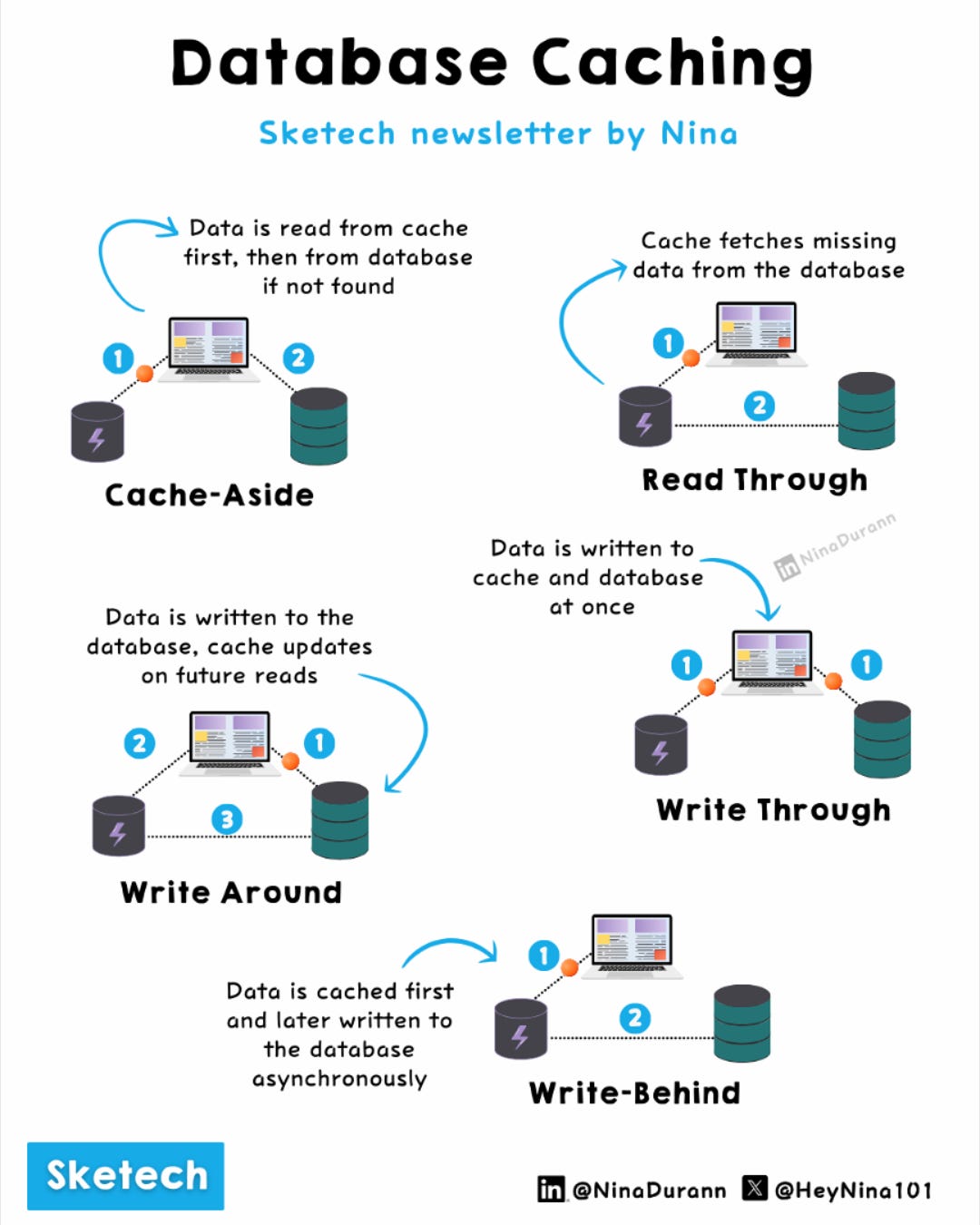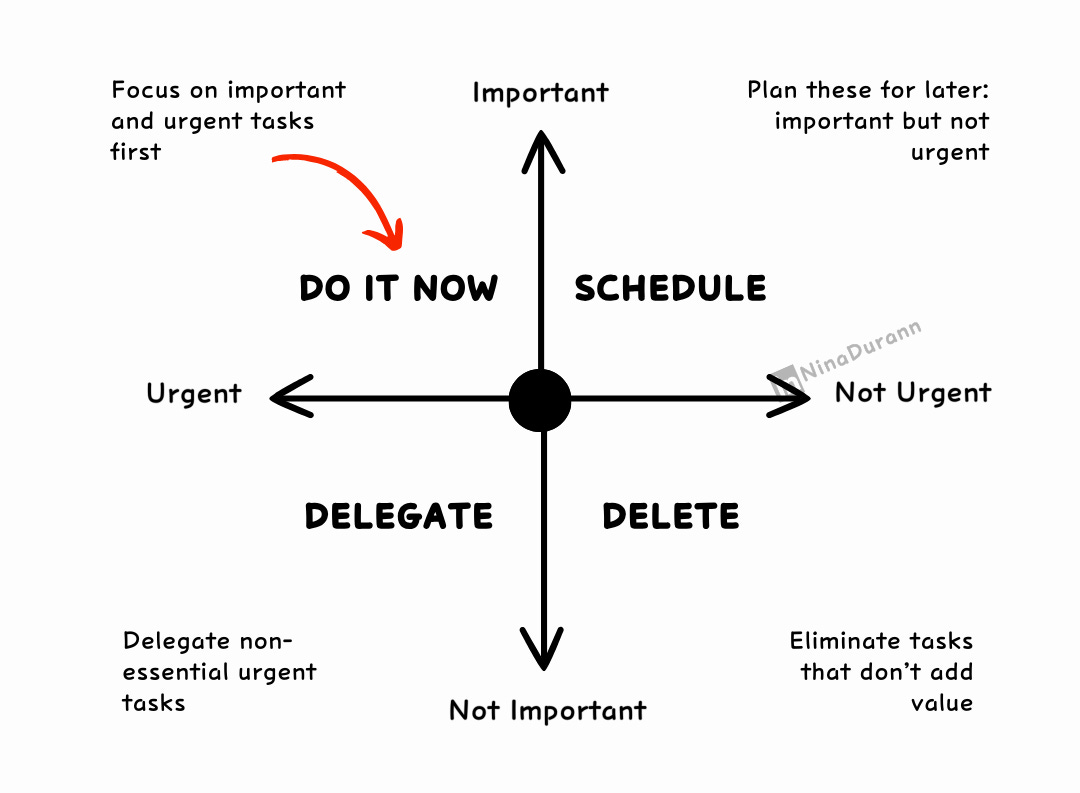Sketech #7 Building Scalable Systems: Sync vs Async Communication, went viral on LinkedIn!
1200+ Interactions Can’t Be Wrong – Here’s Why Sync vs Async Matters!
Welcome back to Sketech — Visual Thinking for Devs
Last week’s post, Building Scalable Systems: Sync vs Async Communication, went viral on LinkedIn! With over 1200 interactions and reaching more than 100,000 members, it’s clear this topic struck a chord. I’m excited to see the impact it had, and I’m diving even deeper into the insights to bring you more value in this edition.
In this edition, you’ll find:
⚡ Diving deep into Building Scalable Systems: Sync vs Async Communication - The Post That Reached 100,000+ on LinkedIn
⚡ 5 Database Caching Strategies Every Developer Needs to Master (Recap)
⚡ Prioritizing What Matters: If a software recruiter asks How You Handle pressure, here’s what you can say (Recap)
⚡ Semantic Versioning: The Roadmap to Clear and Stable Updates (Recap)
Building Scalable Systems: Sync vs Async Communication
Designing scalable software systems demands a strategic approach to communication patterns. Choosing between synchronous (SYNC) and asynchronous (ASYNC) communication methods has profound implications on system performance, resilience, and scalability. Let’s dive deeper into each approach and how to leverage their unique strengths.
Sync Communication (HTTP, gRPC)
Synchronous communication is the default choice when real-time interaction is necessary. It ensures that each request waits for an immediate response, which has both benefits and trade-offs:
↳ Direct interaction
Sync communication works well in scenarios where transactions need confirmation before proceeding. Examples include payment processing, data validation during sign-ups, or critical error checks in user-facing applications.
↳ Consistency at the cost of latency
Since sync communication requires the requesting service to wait, it can guarantee consistency in a sequence of operations. However, this also means that any delays propagate through the system, potentially increasing latency and creating single points of failure.
↳ Resource allocation challenges
Sync systems need careful resource planning, as each active request holds system resources (e.g., threads or connections) until completion. Under heavy load, this can lead to performance degradation, particularly in services handling high concurrent requests without adequate scaling.
↳ Ideal for CRUD operations
Sync communication is often preferred for traditional CRUD (Create, Read, Update, Delete) operations, where data consistency and immediate feedback are prioritized over scalability. Protocols like HTTP and gRPC are widely used here due to their structured request-response model.
Async Communication (Message Queues, Event Streaming, Pub/Sub - e.g., RabbitMQ, Kafka)
Async communication is essential in distributed systems requiring resilience and flexibility. By enabling services to communicate without direct response dependencies, async models unlock several advantages:
→ Fault tolerance
In an async system, if one service is temporarily unavailable, other services continue processing requests independently. Messages are queued and processed once the unavailable service comes back online, reducing the risk of system-wide failures.
→ Event-driven architecture
Async communication enables event-driven systems, where services respond to events rather than direct requests. This architecture supports complex workflows, such as automated workflows in e-commerce platforms (order processing, inventory updates, shipping notifications) without tightly coupling services.
→ Handling burst traffic gracefully
Asynchronous systems are particularly adept at managing sudden spikes in traffic. By queuing requests in brokers like Kafka or RabbitMQ, services can handle bursts without impacting the system’s stability, enabling elastic scaling and minimizing the need for constant resource allocation adjustments.
→ Use cases in microservices
In microservice architectures, async communication facilitates service isolation, making it easier to maintain, update, and scale individual components independently. This approach is fundamental for high-scale applications like social media platforms, recommendation engines, and IoT systems, where services continuously send and receive large volumes of events.
Hybrid Approach: Combining Sync and Async Communication
In real-world scenarios, systems often require a combination of sync and async communication to balance responsiveness and scalability:
Critical path sync, background tasks async: For example, in an e-commerce checkout process, the payment confirmation may be synchronous, ensuring the transaction succeeds in real-time. However, tasks like sending order confirmation emails, updating third-party analytics, or adjusting inventory levels can be handled asynchronously.
Sync communication with async fallback: Systems can use synchronous requests with an async fallback to enhance resilience. If a sync request fails, the data can be sent to a message queue, allowing the request to be retried later or processed asynchronously to avoid data loss or service disruption.
Pattern-based design: Implement patterns like the Circuit Breaker (to manage sync failures gracefully), Bulkhead (to limit resource usage), and Retry with Exponential Backoff (for async resilience) to handle both sync and async failures effectively.
Best Practices for Managing Sync and Async Communication
Implementing sync and async communication methods effectively requires adherence to best practices to maintain system performance and integrity:
Health monitoring and alerting: Track latency, message backlog, error rates, and resource utilization for both sync and async components. Proactive monitoring ensures potential issues are addressed before they escalate.
Data consistency and eventual consistency: Understand that async communication often leads to eventual consistency rather than immediate consistency. For async components, design workflows to tolerate minor delays and establish clear data reconciliation strategies if needed.
Idempotency: Async systems, especially those processing retries or handling bursty traffic, benefit from idempotent operations, ensuring that processing the same message multiple times doesn’t lead to unintended side effects.
Graceful degradation: When scaling async communication, ensure your system can degrade gracefully under load. Implement queue limits, backpressure, and rate limiting to avoid overwhelming downstream services and to maintain system stability.
Want a system that scales?
→ Separate urgent tasks from background processes.
→ Use message brokers to handle high traffic without blocking other services.
→ Monitor queue health and response times to keep things running smoothly.
Sync is precise. Async is flexible. Getting the balance right? That’s where scalable systems start.
Join the conversation on LinkedIn and explore the full post!
5 Database Caching Strategies Every Developer Needs to Master (Recap)
Hooked on Speed? You’ll Love These 5 Database Caching Strategies 🧡
1️⃣ Cache Aside: The application checks the cache first. If data isn’t there, it retrieves it from the database and then stores it in the cache for future requests. Perfect for read-heavy applications where data doesn’t change often.
2️⃣ Read Through: The cache automatically pulls data from the database if it’s not already cached, ensuring data is always available when needed. Ideal for high-traffic applications where missing cache data can slow down performance.
3️⃣ Write Around: Data is written directly to the database, skipping the cache. This approach is useful for applications where recent data doesn’t need to be instantly cached, avoiding unnecessary cache storage.
4️⃣ Write Through: Data is written to the cache and the database simultaneously. This keeps data in sync but may increase latency on writes. Ideal for apps where data consistency is non-negotiable.
5️⃣ Write Back: Data is initially written to the cache and then asynchronously updated in the database. This approach is effective for write-heavy applications where eventual consistency is acceptable.
These caching strategies are powerful, yet tools play a huge role in how effective they are.
𝗪𝗵𝗮𝘁’𝘀 𝗼𝗻𝗲 𝗰𝗮𝗰𝗵𝗶𝗻𝗴 𝘁𝗼𝗼𝗹 𝗼𝗿 𝘁𝗲𝗰𝗵𝗻𝗼𝗹𝗼𝗴𝘆 𝘆𝗼𝘂’𝗱 𝗿𝗲𝗰𝗼𝗺𝗺𝗲𝗻𝗱 𝗳𝗼𝗿 𝗯𝗲𝗴𝗶𝗻𝗻𝗲𝗿𝘀 𝘀𝘁𝗮𝗿𝘁𝗶𝗻𝗴 𝘄𝗶𝘁𝗵 𝗱𝗮𝘁𝗮𝗯𝗮𝘀𝗲 𝗽𝗲𝗿𝗳𝗼𝗿𝗺𝗮𝗻𝗰𝗲 𝗼𝗽𝘁𝗶𝗺𝗶𝘇𝗮𝘁𝗶𝗼𝗻 𝗮𝗻𝗱 𝗮𝗽𝗽𝘀?
My 2 cents... Redis is a fantastic starting point for beginners, it’s fast, reliable and widely used!
Prioritizing What Matters (Recap)
If a Recruiter Asks How You Handle pressure, here’s what you can say:
When this question comes up in an interview, what they’re really looking to understand is how you manage priorities and handle high-intensity situations in software projects.
↳ Start by saying that the key to not feeling overwhelmed is knowing how to set priorities and recognizing when it’s appropriate to ask for help.
↳ Share a specific example: mention a project with a tight deadline where you organized tasks by importance and sought collaboration in essential areas to achieve the best outcome.
↳ Finally, explain how you maintain your mental balance after work, whether through exercise, taking a walk or practicing meditation. This shows that you care for your well-being to sustain high performance in demanding projects.
Here’s a quick look at the Eisenhower Matrix, a tool I use to stay focused on what really matters when the pressure’s on.
Join the LinkedIn conversation on prioritizing what matters
Semantic Versioning: The Roadmap to Clear and Stable Updates (Recap)
Without an adequate versioning system, managing software updates can become chaotic and unpredictable, complicating team alignment and increasing deployment risks.
Among various methods, Semantic Versioning stands out as a structured approach to clearly communicate the scope of each change.
It follows the MAJOR.MINOR.PATCH-PRERELEASE format to indicate the type of modifications made to the software.
𝘃𝟭.𝟬.𝟬-𝗮𝗹𝗽𝗵𝗮.𝟭+𝟭𝟬𝟬𝟭
• Major (v1): Indicates breaking changes that are incompatible with previous versions, signaling to users that careful review is needed.
• Minor (0): Adds backward-compatible functionality, enabling software evolution while maintaining compatibility.
• Patch (0): Resolves bugs and minor fixes without affecting compatibility, essential for quick bug fixes and stability.
• Pre-release (alpha.1): Denotes stages like alpha, beta, and rc (release candidate), allowing teams to test features and gather feedback before final release.
• Build Metadata (+1001): Unique identifiers (e.g., timestamps, build numbers) used to track builds, invaluable for deployment tracing and troubleshooting.
𝗙𝗿𝗲𝗾𝘂𝗲𝗻𝘁 𝗩𝗲𝗿𝘀𝗶𝗼𝗻𝗶𝗻𝗴 𝗖𝗵𝗮𝗹𝗹𝗲𝗻𝗴𝗲𝘀
𝗣𝗿𝗼𝗰𝗲𝘀𝘀 𝗖𝗵𝗮𝗹𝗹𝗲𝗻𝗴𝗲𝘀
→ Inconsistent Versioning: Lack of standardization creates team confusion.
→Unnecessary Version Skips ("Burning Versions"): Missing versions disrupt dependency tracking.
→ Backward Compatibility Management: Poor compatibility planning breaks integrations.
𝗧𝗲𝗰𝗵𝗻𝗶𝗰𝗮𝗹 𝗖𝗵𝗮𝗹𝗹𝗲𝗻𝗴𝗲𝘀
→ Misalignment with Branching Strategies: Version-branch mismatches cause deployment issues.
→ Automation and CI/CD: Complex automation triggers incorrect versioning.
→ Versioning Internal Dependencies and Libraries: Multiple versions create project conflicts.
𝗖𝗼𝗺𝗺𝘂𝗻𝗶𝗰𝗮𝘁𝗶𝗼𝗻 𝗖𝗵𝗮𝗹𝗹𝗲𝗻𝗴𝗲𝘀
→ Unclear Transition from Pre-Release to Final: Ambiguous stages lead to unstable adoption.
→ Ambiguous Version Control Across Multiple Environments: Unclear rules risk production stability.
Semantic Versioning creates a shared language for development teams, DevOps and end users, providing clarity for projects aiming at stability and scalability.
In complex projects, should a person coordinate these tasks? Absolutely. The role of Release Manager becomes indispensable.
Check out the full post on LinkedIn
That’s it for this week! I hope these visuals helped make complex ideas clearer and more actionable for your projects. See you in the next edition – keep creating and refining!






i'm glad you're here